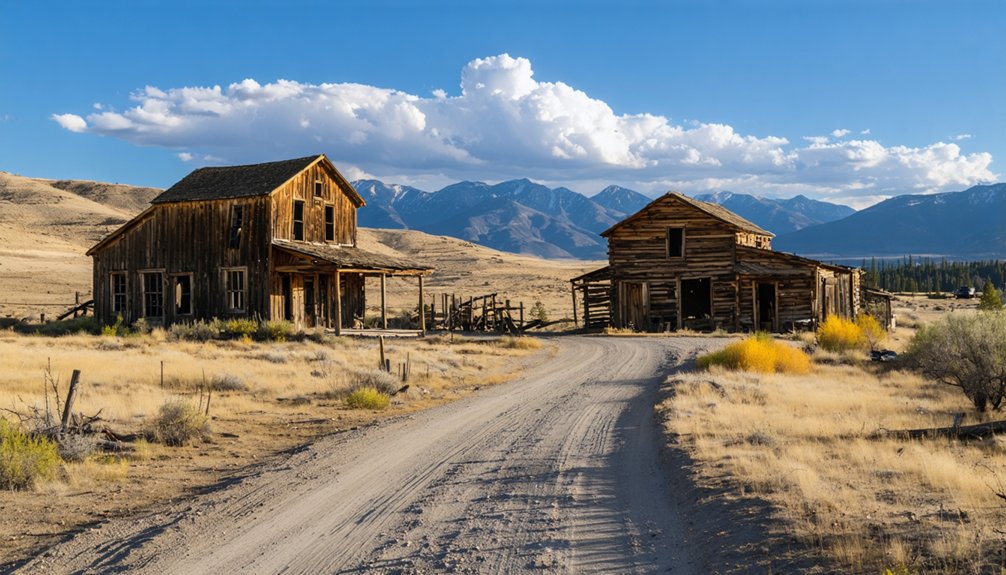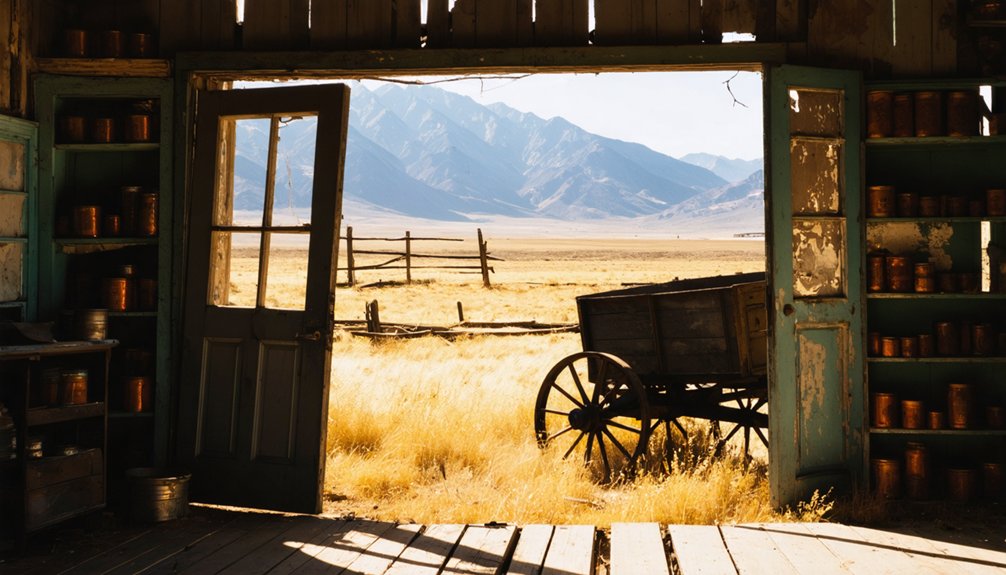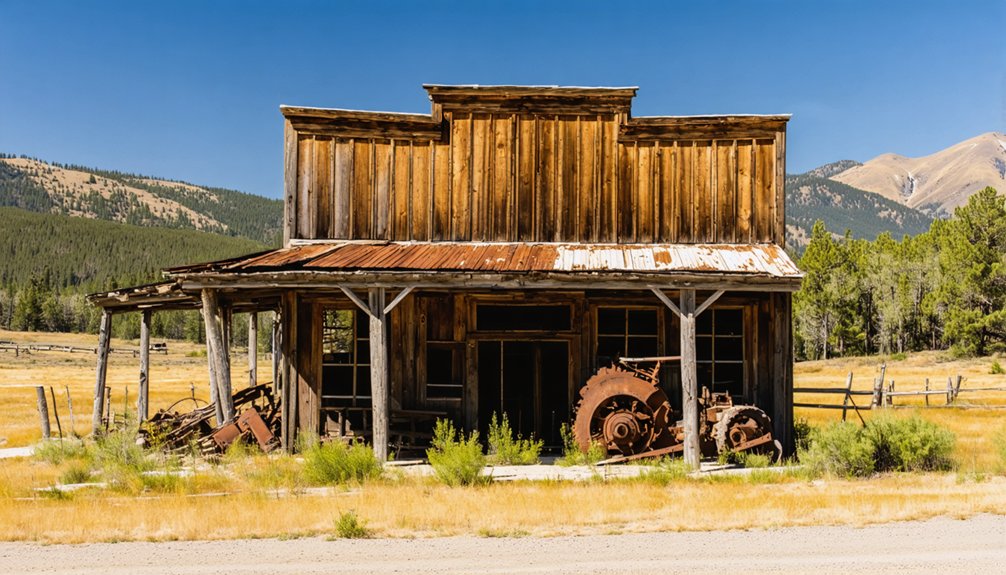You’ll find Old Orogrande tucked away in Idaho’s Buffalo Hump region, where Pete Johnson established this gold mining town in 1894. At its peak, nearly 1,000 residents called it home during the quartz gold boom, with the town generating about $2 million in gold production. Today, crumbling ruins like the Colgrove Hotel foundations dot the 4,600-foot elevation landscape. The site’s remote location and seasonal access preserve countless stories of frontier determination.
Key Takeaways
- Old Orogrande was an Idaho gold mining town established in 1894, reaching its peak population of 1,000 residents in 1869.
- The ghost town produced approximately $2 million in gold through placer, quartz, and dredging mining operations until 1907.
- Located at 4,600 feet elevation near Buffalo Hump, the site features crumbling ruins of the Colgrove Hotel and other historic structures.
- Access is limited to July through October via a 62-mile gravel road, requiring 2WD vehicles in dry conditions or 4WD.
- The town’s remains include foundations of a schoolhouse, general store, and post office, reflecting Idaho’s boom-and-bust mining history.
Discovering the Lost Mining Town
When you venture into the Buffalo Hump Region of Idaho, you’ll discover the remnants of Old Orogrande, a gold mining town that emerged in the late 1800s following the Nez Perce Indian War.
Nestled near the towering 8,926-foot Buffalo Hump granite batholith, this frontier settlement once bustled with nearly 100 residents seeking their fortunes in quartz gold.
Today’s ghost town tourism reveals scattered historic artifacts amid the ruins of what was once a thriving community. You can still find remains of the Colgrove Hotel and explore where saloons, brothels, and wooden sidewalks once served the mining population. Originally established by Pete Johnson in 1894, the town quickly became a vital center of commerce.
Like the original Orogrande in New Mexico that experienced a gold rush in 1905, this Idaho settlement saw its share of fortune seekers.
The town’s strategic location made it a crucial hub among northern Idaho’s mining camps, including nearby Dixie, Elk City, and Newsome, contributing to a documented gold production worth $69,598 between 1902 and 1931.
Life During the Gold Rush Era
You’d find Oro Grande bustling with activity during its 1869 peak, as seven saloons and various boarding houses catered to the largely male population of miners and laborers.
In between grueling shifts at the mines, you could join fellow prospectors at one of the town’s social hubs, where entertainment and ice-cold root beer provided welcome relief from the harsh conditions. The miners had to adapt their work around the challenging terrain, using sluicing small creeks to separate gold from gravel and clay. Winter conditions were especially harsh as fifteen feet of snow typically blanketed the region.
The tight-knit community shared resources and looked out for one another, especially during the brutal winters when snowdrifts would reach second-story windows and force residents to carve stairways through the snow.
Daily Mining Town Life
Life in Orogrande centered around the rhythms of mining work and seasonal challenges, with roughly 1,000 residents at its peak calling this bustling frontier town home.
You’d find miners working their claims with basic mining equipment, while seasonal labor patterns followed nature’s constraints – deep snow in winter and spring floods limiting operations.
If you lived in Orogrande during its heyday, you’d experience:
- Daily trips to the general stores and express offices for supplies and news
- Fresh meat from local grazing herds of over 1,000 head
- The constant buzz of two sawmills producing 11,000 board feet daily
- The bustle of horse teams hauling freight on dusty streets
Your success depended on adapting to harsh conditions while working the placer and quartz claims, often sharing the frontier spirit with fellow prospectors in the town’s saloons and boarding houses.
Gold Rush Social Scene
Despite its remote location, Orogrande’s vibrant social scene revolved around several bustling saloons, hotels, and brothels that served as gathering spots for the town’s thousand-strong population.
You’d find miners sharing news over ice-cold Nesbitt’s Root Beer or stronger drinks after their shifts, while saloon girls and merchants mingled freely in these social gatherings. The saloons weren’t just places to drink – they served as community hubs where you’d handle emergencies, strike business deals, or simply escape the harsh winter weather.
Local boarding houses and hotels fostered community bonds between permanent residents and seasonal workers, while stores and express offices kept everyone connected to the outside world. Whether you were a family settling in or a traveler passing through, Orogrande’s social fabric welcomed all comers.
Notable Buildings and Landmarks
Several notable buildings once stood in Old Orogrande, reflecting the practical needs of this late 1800s mining settlement.
While most structures haven’t survived nature’s toll, their architectural significance lives on through historical records and photographs. The town’s buildings were constructed with native timber, showcasing simple yet functional designs that defined frontier architecture. Like many boomtowns of the 1860s, Old Orogrande faced decline once mining operations ceased. Like the Quinn River CCC Camp, many of these settlements only left behind scattered ruins as evidence of their existence.
- The Orogrande Lodge served as the town’s centerpiece until it was destroyed by fire.
- Miners’ cabins dotted the landscape, built from locally milled timber.
- Essential community structures included a schoolhouse, general store, and post office.
- The railroad’s presence influenced the town’s layout and building placement.
Despite limited preservation efforts, you can still explore the remaining foundations and structural remnants that tell the story of this once-bustling mining community.
Mining Operations and Gold Production
The mining operations in Orogrande evolved through three distinct phases: placer mining in the early years, quartz mining from the late 1800s, and dredging operations during the Depression era.
You’ll find that early mining techniques were heavily influenced by water availability and seasonal conditions, with miners adapting their work schedules around deep snow and high water levels.
The economic impact was substantial, with the district yielding approximately $2 million in total gold production. A mill operated from 1902 to 1931, processing $69,598 worth of gold over its 29-year run.
When the quartz gold boom ended in 1907, mining activities declined until 1932, when operations resumed using draglines.
Though the boom times didn’t last forever, the district’s low-grade gold deposits continued to attract exploration interest into the late 1960s.
Natural Surroundings and Access

You’ll encounter stunning views of Buffalo Hump’s 8,926-foot granite peak as you approach Old Orogrande through the subalpine terrain of Idaho’s Clearwater Mountains.
The ghost town‘s natural setting includes meadows and wooded sections typical of the Elk City mining district, with Little Elk Creek flowing nearby.
While the area’s generally accessible by 2WD vehicles during warm summer months, you’ll need to plan carefully for winter visits when heavy snow can make the gravel roads challenging to navigate. The town sits approximately 11 miles away from New Orogrande.
Mountain Views and Terrain
Nestled at an elevation of 4,600 feet, Old Orogrande sits amid dramatic mountain terrain dominated by Buffalo Hump, an imposing granite batholith that reaches 8,926 feet into Idaho’s sky.
The surrounding mountain ecosystems blend dense forests with open meadows, creating stunning panoramic vistas across Idaho County’s high plateau. The area’s average elevation 1,550m reflects its position in Idaho’s rugged backcountry. Due to the remote location, visitors should use identity verification methods to register their hiking plans with local ranger stations.
You’ll find these remarkable features in the area:
- Summit Flat and Big Creek meadows serve as natural waypoints
- Mixed granite formations create rugged, climbable slopes
- Little Elk Creek valley cuts through the mountainous landscape
- Diverse subalpine forests border rocky ridges and glades
The terrain’s complexity demands respect from visitors, with its combination of steep inclines, forest-covered slopes, and rocky outcrops that once attracted miners to this remote mountain locale.
Seasonal Access Routes
Accessing Old Orogrande requires careful planning across different seasons, with the main route following a 62-mile stretch of mostly gravel road from State Highway 14’s junction with County Road 233.
You’ll find the three-hour journey most manageable between July and October, when seasonal challenges are at their lowest.
While 2WD vehicles can handle the main roads during dry conditions, you’ll want a high-clearance vehicle or 4WD when exploring deeper into the surrounding trails, especially those leading to Wild Horse Lake and Buffalo Hump.
Winter brings significant access limitations due to heavy snowfall, and spring thaws can create muddy conditions that complicate travel. Once you reach the area, you’ll discover several old mining structures from the 1930s still standing.
If you’re planning to bring an RV or trailer, you’ll need to reconsider – the narrow, gravel routes aren’t suitable for larger vehicles.
Daily Life in Old Orogrande
Life in Old Orogrande centered around the daily rhythms of mining activity, with residents rising early to work the quartz gold mines that drew them to this remote mountain settlement.
Miners shaped life in Old Orogrande, their days beginning at dawn to extract precious gold from the mountain’s quartz veins.
You’d find a tight-knit community of about 97 people, including families with school-age children, making the most of frontier living.
- You could grab supplies at the local store, catch up on news at the post office, or join fellow miners at one of several saloons.
- Your children would attend school with 15 others, fostering strong community bonds.
- You’d trade with neighboring communities using pack animals and wagons.
- After a hard day’s work, you’d gather at the Colgrove Hotel, the social hub where miners shared stories and merchants conducted business.
Legacy of a Forgotten Frontier

While Old Orogrande‘s brief heyday has long since faded, its legacy endures as a quintessential example of Idaho’s boom-and-bust mining era.
You’ll find its forgotten history etched in the crumbling ruins of the Colgrove Hotel and scattered remnants of what was once a bustling frontier town of up to 1,000 souls.
Like many transient communities of the American West, Old Orogrande emerged swiftly when gold was discovered and vanished just as quickly when the precious metal ran out.
Today, where stores, saloons, and sawmills once stood, you’ll see only a meadow and an old cabin.
Yet this ghost town’s story lives on, reminding you of the untamed spirit of Idaho’s mining pioneers who carved out a temporary civilization in the rugged Clearwater Mountains, driven by dreams of striking it rich.
Frequently Asked Questions
Are There Any Reported Ghost Sightings or Paranormal Activity in Old Orogrande?
While whispers of ghosts drift through Idaho’s mining towns, you won’t find documented ghost encounters or paranormal investigations in Old Orogrande’s ruins – just windswept meadows and crumbling foundations telling mining tales.
What Happened to the Gold Mining Equipment After the Town Was Abandoned?
You’ll find most gold mining equipment was abandoned, left to rust and decay in harsh weather. Some pieces were taken by miners, while nature and time claimed what remained without historical preservation.
Were There Any Famous Outlaws or Notable Crimes in Old Orogrande?
You won’t find any famous outlaws or notable crimes documented in Orogrande’s history. While the town had typical mining-era lawlessness with saloons and brothels, only minor thefts and disputes were reported.
Did Any Native American Conflicts Occur Specifically in Old Orogrande?
Like finding a needle in a haystack, there’s no concrete evidence of native tribes engaging in conflicts specifically at Old Orogrande, though regional conflict history shows tensions existed throughout Idaho’s mining areas.
What Were the Most Common Causes of Death in Old Orogrande?
You’d have faced the deadliest threats from mining accidents like cave-ins and dynamite explosions, while disease outbreaks and winter exposure claimed lives in the harsh conditions of isolated camps.
References
- https://oregontrailgenealogy.com/the-ghost-town-thats-really-a-ghost/
- https://history.idaho.gov/wp-content/uploads/0366.pdf
- https://dustywindshield.wordpress.com/2016/09/10/orogrande-mining/
- https://history.idaho.gov/wp-content/uploads/2018/08/0064.pdf
- https://dustywindshield.wordpress.com/2019/08/19/buffalo-mining-region-orogrande-the-colgove-hotel/
- https://www.ghosttowns.com/states/id/oldorogrande.html
- https://westernmininghistory.com/towns/idaho/elk-city/
- https://www.newmexico.org/places-to-visit/ghost-towns/orogrande/
- https://wheninyourstate.com/idaho/hidden-in-idaho-the-ghost-town-built-on-broken-promises-to-the-nez-perce/
- https://visitidaho.org/things-to-do/ghost-towns-mining-history/



